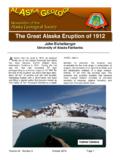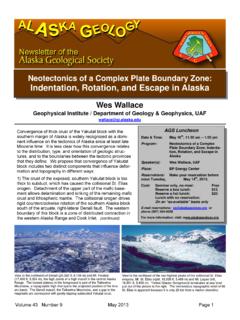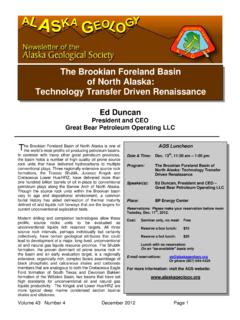Transcription of 2014 AGS Technical Conference - Alaska Geological …
1 Abstracts with Program University of Alaska Anchorage ConocoPhillips Integrated Science Center May 15, 8:30-4:30 Including, Bird to Hatcher Pass Field Trip May 16 Led by Sue Karl and Chad Hults Printed courtesy of ConocoPhillips Alaska , Inc. Cook Inlet Gateway to Alaska 2014 AGS Technical Conference Sponsored By: Letter from the President Dear participants of the 2014 AGS Technical Conference , Welcome and thank you for attending this event. It s been an honor to be the Alaska Geological Society President for this past year and have the chance to see this Conference come to fruition. My part in this has been small so all the credit goes to Chad Hults and his Conference committee. They have put together quite a program of talks, posters and a sold out field trip in a relatively short amount of time.
2 Having seen efforts in the past come to naught I know how difficult it can be to finally put an event like this together. This Conference is the culmination of an impressive series of luncheon talks put on by the AGS and in conjunction with the Geophysical Society of Alaska and SPE Alaska . It is a fitting end to a fine year. A title like Cook Inlet Gateway to Alaska provides a focus but also promises a broader range of topics. I think you ll find the subjects in the speakers schedule to reflect this and I encourage you to follow up with the authors. There is always more behind what goes into a 20 minute talk than what can be adequately communicated in that time. The poster sessions and the field trip naturally provide this kind of opportunity, so don t avoid taking advantage of it.
3 The field trip especially should provide a great opportunity to bring together everything you ve just heard from the day before. The 2014 AGS Technical Conference is dedicated to Joe Kirchner, retired petroleum geophysicist at BP and senior consultant for Golder Associates, and retired DGGS geologist and endurance athlete Rocky Reifenstuhl. Both AGS members passed away recently and were well respected geologists and gentlemen of first degree. I want to make sure to thank everyone involved in bringing this Conference together. I also want to acknowledge our sponsors Canrig, ConcoPhillips, Hilcorp, PRA, and Schlumberger. Their help and support is fundamental to bringing these events to you now and in the future so make an effort to thank their representatives and let them know how much you appreciate it.
4 Please have a great time and take advantage of making or renewing friendships along with learning more about the geology of Cook Inlet and the rest of Alaska . ~Matt Matt Frankforter President, Alaska Geological Society 1 Welcome from the Conference Chair the Conference theme Cook Inlet Gateway to Alaska was inspired by the recent release of the AAPG Memoir 104 Oil and Gas Fields of the Cook Inlet Basin, Alaska , increased exploration, and the recent studies by the Alaska Division of Geological and Geophysical Surveys and the U. S. Geological Survey. The theme also has a deeper meaning, in that much of modern exploration of mainland Alaska started in the Cook Inlet area, and the first significant oil discoveries in Alaska were found in Cook Inlet. In order to provide a diverse range of topics, the AGS board decided to keep the Cook Inlet talks to about half the program, hence Gateway to Alaska .
5 In addition to the Conference , we thought it would be good to provide a field trip, so that members would have a chance to spend time together outside on the outcrops in our backyard. There are some significant new studies that have reinvigorated our interest and reshaped our interpretations of these easily accessible rocks. Hopefully this field trip will spur thoughtful discussions and will be a good social occasion where members can form new connections, future collaboration, and, most importantly, friendships. Demand for the field trip was much greater than expected, so hopefully we can have a field trip as part of future annual AGS Technical conferences. A big thank you to the presenters that volunteered to talk or give posters. Thanks to all those that volunteered to help get the meeting logistics organized and the venue prepared.
6 The annual AGS Technical Conference is a great venue for geologists to convene and discuss recent work on Alaskan geology. I look forward to the AGS Technical Conference every year and have enjoyed coordinating this year s Conference . We switch the venue from north of the Alaska range to south every year, so next year s Conference will be held in Fairbanks. AGS is looking for a volunteer in Fairbanks to chair the next Conference . Finally, the AGS board and the AGS members want to thank the sponsors that helped cover some of the Conference expenses, so that the fee for the Conference was kept reasonable. Cheers Chad Hults 2 Program Schedule 8:00 Doors Open 8:30 Opening Remarks 8:45 Rocky Reifenstuhl and Joe Kirchner Tribute 9:00 30 Carl Tape Geological influences on the seismic wavefield in Alaska 9:30 30 Patrick Druckenmiller Dinosaur tracks from the lower Yukon River; an extensive new record for Arctic dinosaurs in Alaska 10:00 20 Break, with refreshments provided by PRA 10:20 20 Chad Hults Two flysch belts having distinctly different provenance suggest no stratigraphic link between the Wrangellia composite terrane and the paleo-Alaskan margin 10:40 20 Richard Lease Arctic Alaska basin evolution: insights from detrital zircons 11:00 30 Rick Saltus A tilted bed for the sleeping lady?
7 - Gravity and magnetic evidence for a thrust-fault interpretation of the Mt Susitna/Beluga Mtn front 11:30 30 Buffet Lunch Served 12:00 5 Sue Karl - Scholarships 12:05 55 Dave LePain (Keynote) Geologic framework of Cook Inlet basin, south-central Alaska : The depositional systems perspective 1:00 10 Break 1:10 20 Bob Gillis Structural, stratigraphic, and thermochronologic evidence for Eocene transtension and exhumation along the arc-forearc margin, Cook Inlet 1:30 20 Matt Frankforter Modeling concepts for reservoir geometries in the Trading Bay Field, Cook Inlet 1:50 30 Michael Richter Petroleum geology of Alaska s interior rift basins 2:20 20 Tim Ryherd Cook Inlet and non-North Slope production and revenue 2:40 20 Marwan Wartes Predicting deep-water reservoirs in the Brookian Sequence: Underexplored plays on the North Slope, 3:00 Poster Session 3:30 Social Hour with refreshments sponsored by Schlumberger 3 Presentation Abstracts Toward using the seismic wavefield to image subsurface geology in Alaska Carl H.
8 Tape, University of Alaska Fairbanks, Seismic waves from local earthquakes are strongly influenced by Geological structures, such as topography, sedimentary basins, and variations of subsurface lithology. In active tectonic regions such as Alaska , the variations within the crust are strongly pronounced, and therefore so are the variations in the seismic wavefield. Seismic imaging seeks to use information within seismograms (basically lots of wiggles) to improve our initial description of the Earth's structure. Within a formal inverse problem, we minimize the difference between recorded seismograms and modeled seismograms, while iteratively improving our characterization of the subsurface Earth structure. Seismic imaging in Alaska requires an initial 3D characterization of the crustal structure in terms of variations in density and elastic parameters ( P wave speed and S wave speed).
9 We use a 3D seismic model of Alaska that contains some of the major sedimentary basins, such as Cook Inlet basin and Nenana basin, embedded within a crustal model derived from previous seismological studies. Previous crustal imaging efforts in California suggest that we should be able to resolve subsurface variations with length scales of 4 km vertically and 12 km laterally. Resolving finer scale structures should be possible in regions with denser coverage of seismic stations or active source experiments. The long-term objectives for wavefield-based seismic imaging in Alaska are to provide the most accurate possible 3D seismic model in order (1) to produce accurate ground motion estimates for hazard assessment and (2) to help interpret the current and ancient tectonic setting of Alaska . 4 Dinosaur tracks from the lower Yukon River; an extensive new record for Arctic dinosaurs in Alaska Patrick S.
10 Druckenmiller1, Kevin May1, Paul McCarthy2, J rn Hurum3, Katherine Anderson4, 1) University of Alaska Museum, 2) Department of Geology and Geophysics, University of Alaska Fairbanks, 3) University of Oslo Natural History Museum, 4) Department of Geology and Geophysics, University of Alaska Fairbanks, Globally, only a handful of localities are known to preserve a record of dinosaurs that lived at high paleo-latitudes. Two of the best-known high latitude sites occur in Alaska : the Prince Creek Formation on the North Slope and the Cantwell Formation in Denali National Park and Preserve. While both of these localities record valuable information on terrestrial Arctic ecosystems from the very latest Cretaceous (Maastrichtian), data from stratigraphically older sites has been sparse. In the summer of 2013, fieldwork conducted by the University of Alaska Museum resulted in the discovery of a prolific new dinosaur ichnofossil assemblage along the Yukon River in west-central Alaska .











